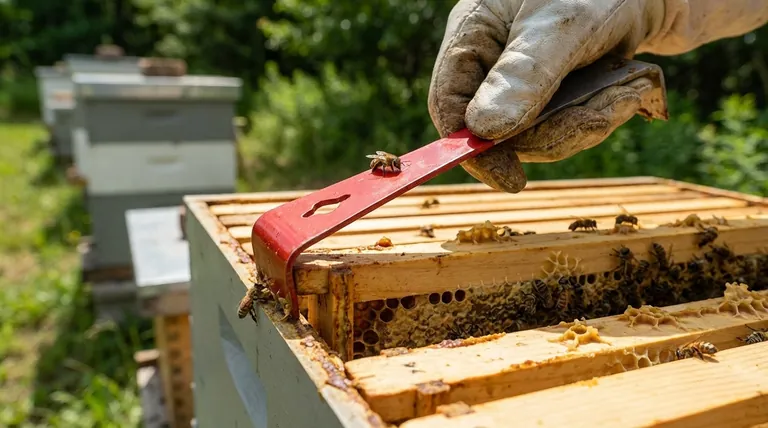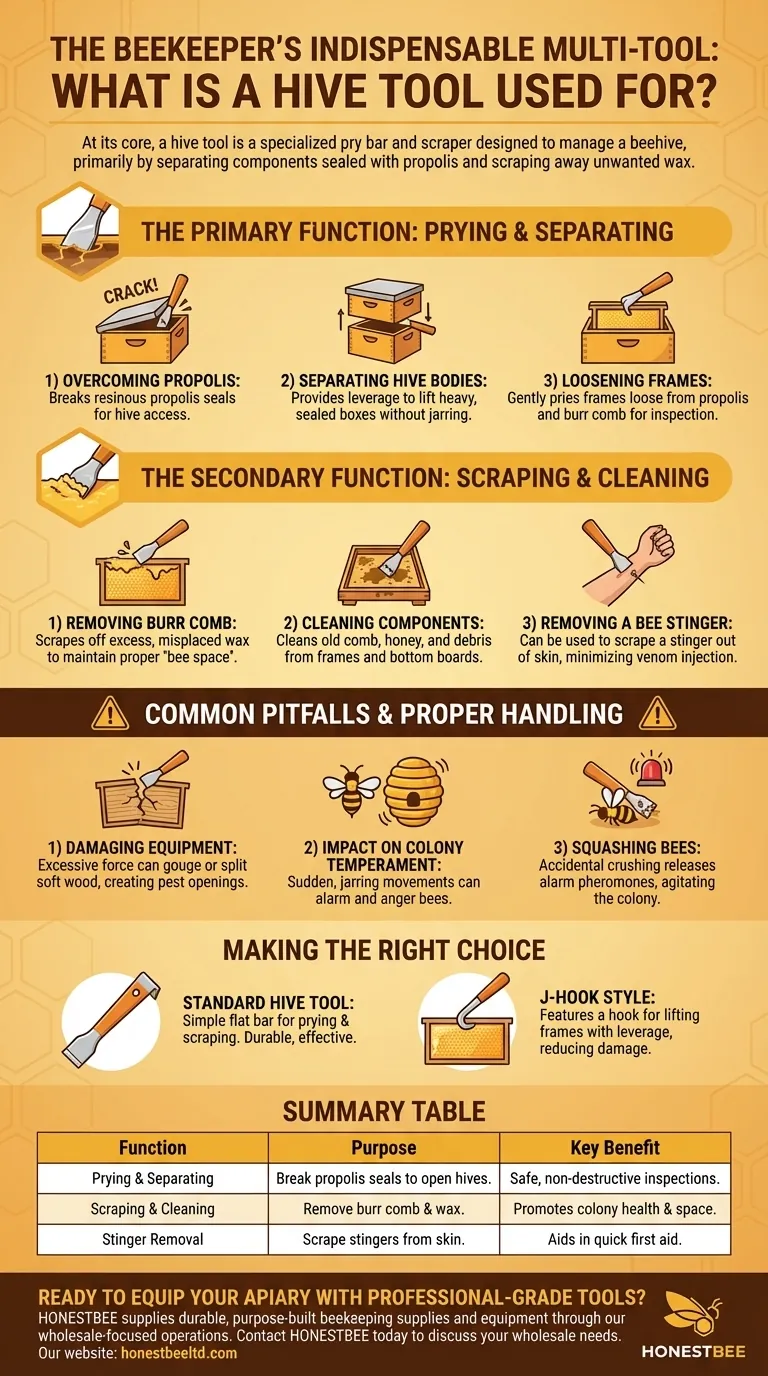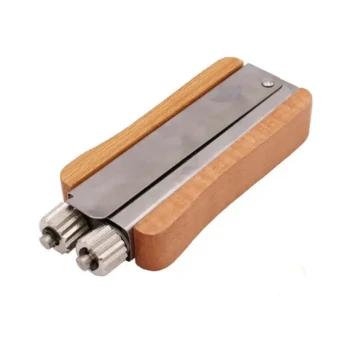At its core, a hive tool is the beekeeper's indispensable multi-tool. It is a specialized, hand-held pry bar and scraper designed specifically to manage the unique challenges of a beehive. Its primary functions are to separate hive components sealed by the bees with a substance called propolis and to scrape away unwanted wax and debris.
A hive tool is more than just a pry bar; it is the essential interface between you and the colony. Understanding its functions is the first step toward inspecting and managing a hive safely and effectively, allowing you to work with the bees' natural construction, not against it.

The Primary Function: Prying and Separating
Bees use a resinous, glue-like substance called propolis to seal every crack and seam in their hive for structural integrity and defense. This makes opening and inspecting the hive impossible without a strong, thin prying tool.
Overcoming Propolis
The hive tool’s beveled edge is designed to be gently inserted between hive components—such as the top cover and the hive body—that have been glued shut.
A slight twist or gentle pressure is all that's needed to break the propolis seal with a characteristic "crack." This allows you to gain access to the interior of the hive.
Separating Hive Bodies
During an inspection, you often need to lift one box (or "super") off another. These boxes are heavy and are almost always sealed together with both propolis and bits of wax.
The hive tool provides the necessary leverage to separate these vertical components safely, preventing you from jarring the hive or damaging the wooden boxes.
Loosening Frames
Frames of honeycomb are packed tightly together inside the hive body. Bees will use propolis and burr comb (misplaced wax comb) to fix these frames in place.
The hive tool is used to gently pry the first frame loose from the side of the hive body. Once the first frame is out, the others can be shifted and removed more easily for inspection.
The Secondary Function: Scraping and Cleaning
Beyond prying, the hive tool is a master scraper, essential for maintaining a clean and well-organized hive environment.
Removing Burr Comb and Excess Wax
Bees don't always build comb where you want them to. The flat edge of the hive tool is perfect for scraping off this unwanted burr comb from the tops of frames, inner covers, and other surfaces.
This keeps the hive tidy and ensures the proper "bee space" between components is maintained, preventing frames and boxes from becoming permanently stuck together.
Cleaning Hive Components
Over time, propolis and wax build up on all hive parts. The tool is used to scrape old comb, honey, and debris from frames during honey extraction or from bottom boards during a spring cleaning.
A clean hive is a healthier hive, and the hive tool is the primary instrument for this type of hive hygiene.
Removing a Bee Stinger
In a pinch, the flat, scraping edge of the tool can be used to scrape a stinger out of your skin. This is preferable to pinching and pulling, which can squeeze more venom from the venom sac into your body.
Common Pitfalls and Proper Handling
While robust, a hive tool requires finesse. Using it improperly can cause more harm than good, both to your equipment and your bees.
The Risk of Damaging Equipment
The most common mistake is using the hive tool with excessive force. This can gouge or split the soft pine wood of your hive bodies and frames, creating openings for pests and reducing the lifespan of your equipment.
Always apply gentle, steady pressure. Let the tool's leverage do the work rather than your brute strength.
The Impact on Colony Temperament
Sudden, jarring movements when prying open a hive can alarm and anger the bees, leading to a more defensive and difficult inspection.
Work slowly and deliberately. When breaking a propolis seal, do it smoothly to minimize vibrations and disturbances passed through the hive.
Squashing Bees
When scraping frames or prying them apart, it is easy to accidentally crush bees. Be mindful of where your tool is and move slowly, giving bees a chance to get out of the way. A crushed bee can release an alarm pheromone that agitates the rest of the colony.
Making the Right Choice for Your Goal
Not all hive tools are identical. Your choice depends on your primary beekeeping tasks.
- If your primary focus is simple prying and scraping: A standard hive tool, which is a simple, flat bar with a bent end for scraping, is durable, effective, and inexpensive.
- If your primary focus is easily lifting frames: A "J-hook" style tool features a small hook on one end. This hook is specifically designed to fit over the top bar of a frame, giving you excellent leverage to lift it straight up without damaging the frame or disturbing adjacent frames.
Ultimately, the hive tool is the single most important piece of equipment you will use, turning the impossible task of opening a sealed hive into a manageable routine.
Summary Table:
| Function | Purpose | Key Benefit |
|---|---|---|
| Prying & Separating | Break propolis seals to open hives and separate boxes/frames. | Enables safe, non-destructive hive inspections. |
| Scraping & Cleaning | Remove burr comb and excess wax to maintain hive hygiene. | Promotes colony health and proper bee space. |
| Stinger Removal | Scrape stingers from skin to minimize venom injection. | Aids in quick first aid during hive management. |
Ready to equip your apiary with professional-grade tools?
For commercial apiaries and equipment distributors, the right tools are the foundation of efficient and safe operations. HONESTBEE supplies durable, purpose-built beekeeping supplies and equipment through our wholesale-focused operations, helping you manage your hives more effectively and scale your business.
Contact HONESTBEE today to discuss your wholesale needs and discover how our equipment can support your success.
Visual Guide

Related Products
- Professional Steel Pry-Bar Hive Tool with Painted Grip
- HONESTBEE Advanced Ergonomic Stainless Steel Hive Tool for Beekeeping
- HONESTBEE Premium Italian Style Hive Tool with Hardwood Handle
- HONESTBEE Professional Long Handled Hive Tool with Precision Cutting Blade
- Professional Multi-Function Stainless Steel Hive Tool
People Also Ask
- What are some safety precautions and care tips for hive tools? Ensure Beekeeping Efficiency and Hive Health
- Why is it recommended to have multiple hive tools? Boost Efficiency & Prevent Downtime
- What is the purpose of the J-hook hive tool? Effortlessly Lift Frames with Superior Leverage
- What equipment and implements are needed by beekeepers besides the hives? Build Your Essential Beekeeping Toolkit
- Why is it recommended to have multiple hive tools on hand? Essential Tips for Efficient Beekeeping



















